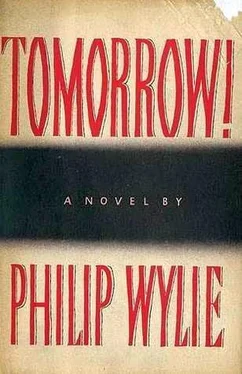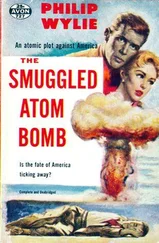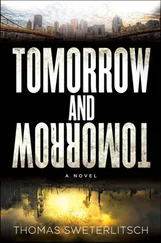The group was absolutely silent. Men smoked. One man even blew his nose. But nobody said anything for a long while. The flags moved toward Chicago, Chuck saw, and Indianapolis, Detroit and Toledo. There were scarlet flags on four cities—all of them, Chuck observed, coastal cities and big ones: San Francisco, Los Angeles, New York and Philadelphia.
Finally General Boyce spoke. Chuck couldn’t see him because he was shorter than most of the other officers and stood closest to the map.
“It appears that the assault from the south is a small wave. Note it seems to have broken into three parts. Nothing coming this way. The northern waves, both of them, split east and west.
It would seem, gentlemen, that we aren’t on the target list.”
Those words were followed by a quiet but ubiquitous murmur as the men addressed each other. That gave Charles a chance to say to the lieutenant colonel, who stood beside him, “What are the scarlet flags?”
“H-bombs.”
Chuck felt sick. He didn’t answer.
Now, to his astonishment, a civilian pushed out from the crowd. Chuck recognized him, though he was ash-pale, almost blue-lipped and his features were screwed up with the torture of his fears and his determination. It was River City’s Mayor Clyde. “I repeat, General,” he said almost in a shout, “if we are not yet threatened, we must maintain Condition Yellow! You start those sirens and you sign the death warrant of maybe a thousand people. Great God! The whole population and the county around is jammed downtown, and they’d panic!”
The general followed the mayor and the men parted to make a clear path. “I know. I know. And decision here depends only on emergency. Nothing has come through from the Second Army. Zinsner!” he called.
The man with the headphones heard and removed them. ‘‘Yes, sir?”
“Anything from Colorado Springs?”
Zinsner spoke, inaudibly, into a mouthpiece he held in his hand, waited-while the room waited-and shook his head. “No word, sir.”
“But you have contact?”
“Certainly, sir. That is—we still do.”
General Boyce, Major General Boyce, paced in front of a desk, on the thick carpeting.
Mayor Clyde followed him for a little while, gave up, leaned against the desk and wiped his face with a big linen handkerchief. He got out a cigar and lit it. The general faced the room abruptly.
“What’s your opinion, Berdich?”
A man wearing eagles, a man with a thin face, very white skin, pale gray eyes and an Adam’s apple that traveled up and down above his collar when he talked, said, “Can we properly call this an emergency? Our radar has a range of better than two hundred miles. So far, we have accounted for every blip—”
General Boyce lost his patience. “Good God, Berdich, I don’t want a résumé ! Just, ‘Yes’ or ‘No.’”
“No,” Colonel Berdich said.
The mayor looked at him in a gratified but still-frantic fashion.
“Tetley?” asked the general. A tall, dark man, who looked more like a college professor than a soldier, stepped forward through the group. He was a major.. He said, “I say Yes.”
“Why?”
“From what we can gather, the little coming in, I suspect some of the attacks are by guided missiles, homing on the cities, launched from the air. Range could easily outreach our radar and the speed would be supersonic. Even two hundred miles might not give us a Red Condition time of even ten minutes.”
“Ten minutes is still ten minutes,” the mayor muttered.
Boyce whirled. “Ever try to empty a thirty-story building in ten minutes?” He began to pace again. “Trouble is, there’s no official operational plan for precisely this situation!”
Another officer said, in a remarkably calm tone, “We’ve got the area ringed with search.
No report. That gives us about five hundred miles.”
“We’ll wait,” the general finally said.
As if that were a command, the men clustered around the map again, watching to see what changes were made according to reports relayed in a near-whisper by Zinsner to the men who moved the pins and Hags.
The difficulty at Hink Field was the difficulty experienced in those same hours at many other military installations. Stations that should have given reports had vanished. Cities close to command areas, like Denver, had been hit and the news had not yet reached the right information centers: what had happened in Colorado’s capital was unknown for seventy-six minutes at the military communications heart in Colorado Springs. The knowledge then arrived—as a rumor.
Some command centers had, themselves, been stricken and posts dependent upon them waited vainly for orders. Beyond that, some Air Force bases so concentrated upon defense activity that it was impossible to find wires for a steady alert service to near-by cities.
Here and there, over the entire continent, the sky was peopled with dying young Americans and their dying enemy. Many older officers, on the ground, followed the pattern of their training and decided that it was of greater import to attack the swiftly materializing foe than to keep the civil centers posted at the cost of time, energy, communications and frantically needed personnel.
It is always so. The beleaguerment is foreseen, on paper, and acted out in drills and games of war. The curve of crises, the links of possible catastrophe, are known ahead of time.
They are “possibilities.” Within their limits, a military effort is made to account for every circumstance. Friendly officers play the part of the “enemy” and plan every conceivable attack.
“X-Day” plans are drawn up, studied from every angle, stamped ‘‘Top Secret” and filed away.
To be sure, chains-of-command are notified concerning them; communications and alternate communications are established; and whatever else seems required for every emergency is fashioned and stockpiled, or learned by troops, or kept on hand—or, if the appropriations do not meet the dire extremes of military vision, at least exists on paper.
Surprise assault has rarely found the adversary ready. At Pearl Harbor, the radar worked, the in-flying enemy was seen in ample time to change that masterpiece of ruin, but a weak military link in the chain cut off fact from command. The nation then being attacked, the United States, believed many wrong things: that their planes were far superior; that the Japs had a congenital defect of eyesight which incapacitated them as pilots. Those Americans who thereupon died like flies before the guns of Zeroes had only a moment in which to see how mistaken they and their countrymen had been. The inferiorities then—as in this later case—and the defects, too, were American.
Faced by that ultimate martial calamity, inconceivable and majestic—invasion with atomic arms—most military men reverted (as their long discipline had made sure they should) to conventional means and ends. This was war; this, therefore, was not the affair of civilians. Their duty was to defend and defense spelled attack. Their ideology, their often logical position was this: that it mattered more in the flickering instants to bring down a grievously armed enemy plane than to keep any given city, only potentially menaced, in step-by-step contact with events which occurred so fast in any case that the best-informed staffs were soon far behind.
Much, of course, that was needed now and in a certain place was stored elsewhere, or existed in insufficient quantity, or could not be got ready in time, or it existed only in prototype, or on order—or merely in blueprints, as a dream might exist.
Much was expended in error. The rockets that ringed Detroit went up, after mistaken recognition signals, and destroyed seven American bombers two hours before the single Soviet plane launched its missile onto Detroit from a position far to the north, far beyond the range of the improved Nike, in Canada.
Читать дальше












